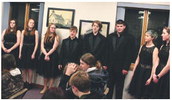Starting over


Parent concerns prompt school to review finger scanning for lunch lines
Seconds add up. At least that was what the school district administrati...


Parent concerns prompt school to review finger scanning for lunch lines
Seconds add up. At least that was what the school district administrati...